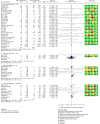Omega-3, omega-6 and total dietary polyunsaturated fat on cancer incidence: systematic review and meta-analysis of randomised trials
- PMID: 32114592
- PMCID: PMC7156752
- DOI: 10.1038/s41416-020-0761-6
Omega-3, omega-6 and total dietary polyunsaturated fat on cancer incidence: systematic review and meta-analysis of randomised trials
Abstract
Background: The relationship between long-chain omega-3 (LCn3), alpha-linolenic acid (ALA), omega-6 and total polyunsaturated fatty acid (PUFA) intakes and cancer risk is unclear.
Methods: We searched Medline, Embase, CENTRAL and trials registries for RCTs comparing higher with lower LCn3, ALA, omega-6 and/or total PUFA, that assessed cancers over ≥12 months. Random-effects meta-analyses, sensitivity analyses, subgrouping, risk of bias and GRADE were used.
Results: We included 47 RCTs (108,194 participants). Increasing LCn3 has little or no effect on cancer diagnosis (RR1.02, 95% CI 0.98-1.07), cancer death (RR0.97, 95% CI 0.90-1.06) or breast cancer diagnosis (RR1.03, 95% CI 0.89-1.20); increasing ALA has little or no effect on cancer death (all high/moderate-quality evidence). Increasing LCn3 (NNTH 334, RR1.10, 95% CI 0.97-1.24) and ALA (NNTH 334, RR1.30, 95% CI 0.72-2.32) may slightly increase prostate cancer risk; increasing total PUFA may slightly increase risk of cancer diagnosis (NNTH 125, RR1.19, 95% CI 0.99-1.42) and cancer death (NNTH 500, RR1.10, 95% CI 0.48-2.49) but total PUFA doses were very high in some trials.
Conclusions: The most extensive systematic review to assess the effects of increasing PUFAs on cancer risk found increasing total PUFA may very slightly increase cancer risk, offset by small protective effects on cardiovascular diseases.
Conflict of interest statement
S.H., G.T., A.S.A. and L.H. had financial support via the University of East Anglia from the World Health Organization for the submitted work, and L.H. and A.A. were also funded to attend WHO meetings and present review results; no financial relationships with any organisations that might have an interest in the submitted work in the previous three years; no other relationships or activities that could appear to have influenced the submitted work.
Figures





References
-
- Cancer Research UK. Worldwide Cancer Statistics https://www.cancerresearchuk.org/health-professional/cancer-statistics/w...: Cancer Research UK. Available from: https://www.cancerresearchuk.org/health-professional/cancer-statistics/w... (2019)
-
- Ritchie, H. How many people in the world die from cancer? Our World in Data. Available from: https://ourworldindata.org/how-many-people-in-the-world-die-from-cancer (2019).
-
- World Health Organization (WHO). Global Status Report on Noncommunicable Diseases 2014. Geneva, Switzerland. http://apps.who.int/iris/bitstream/10665/148114/1/9789241564854_eng.pdf?...: (WHO, 2015).
-
- Barnes PM, Bloom B, Nahin RL. Complementary and alternative medicine use among adults and children: United States, 2007. Hyattsville, MD: US Department of Health and Human Services, Centers for Disease Control and Prevention, National Center for Health Statistics; 2008. - PubMed
Publication types
MeSH terms
Substances
Grants and funding
LinkOut - more resources
Full Text Sources
Other Literature Sources
Medical

